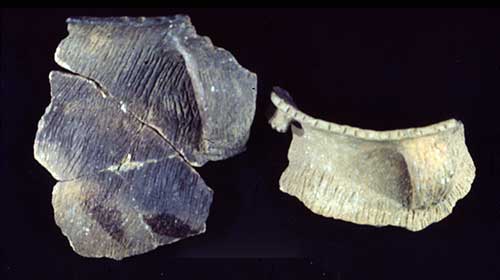Use of Native and European American Goods
At Lower Shawneetown, Late Fort Ancient ceramics and chipped stone tools were contextually associated in the same trash disposal area as mid-eighteenth century European American trade goods. These trade goods were diverse: ornaments, but also firearms (gun parts, gunflints, and ammunition) and items of domestic use, such as scissors, knives, and mouth harps.
This contrasts sharply with where investigators found European American trade goods within mid-seventeenth-century Late Fort Ancient villages and what the trade goods were. These items were recovered exclusively from burial contexts, and most were ornaments - glass beads or copper beads derived from reworked fragments of brass or copper kettles.
The contemporary use of both Native-produced and European American-made goods at Lower Shawneetown points to the enduring quality of Native cultural traditions that extended into the mid-1700s, well after sustained, direct contact with European Americans.
